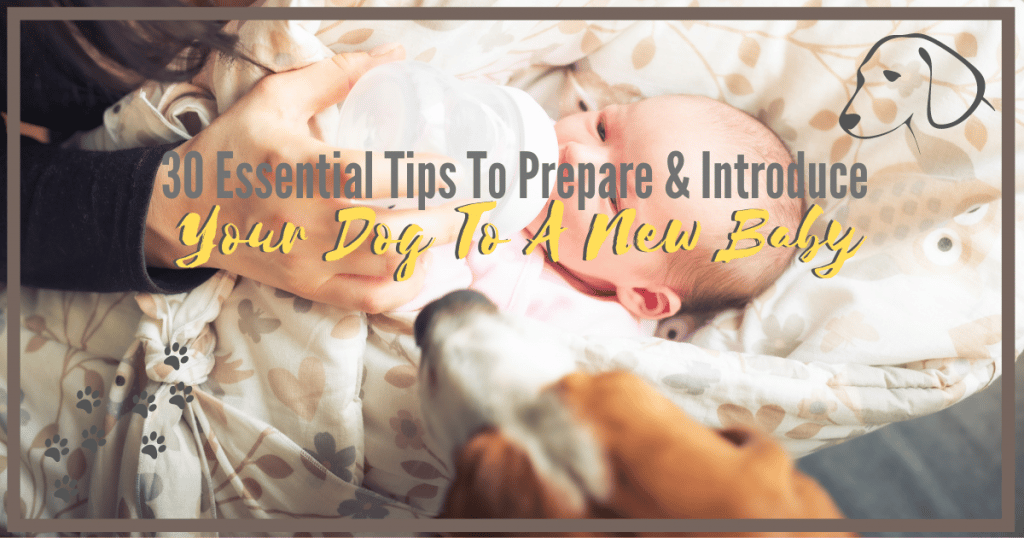My husband and I grew up with dogs. So it was only natural for us to add a few furbabies to our clan soon after we bought our first home. They became part of the family, and we gave them plenty of care and attention.
It was several years later that we were blessed to adopt a human baby. And that meant big changes for our dogs. They had competition for affection, and the home was a lot noisier!
Whether you’re having a baby yourself or planning to adopt, there are some things you can do to make the transition easier for your pooch. If you get started early with preparing Fido for the new addition, things may go much more smoothly. Below I’ll share some tips to help you adjust from a pet parent to a parent with pets.
But first, if you’re pregnant, you may be wondering…
Can my dog sense my pregnancy?
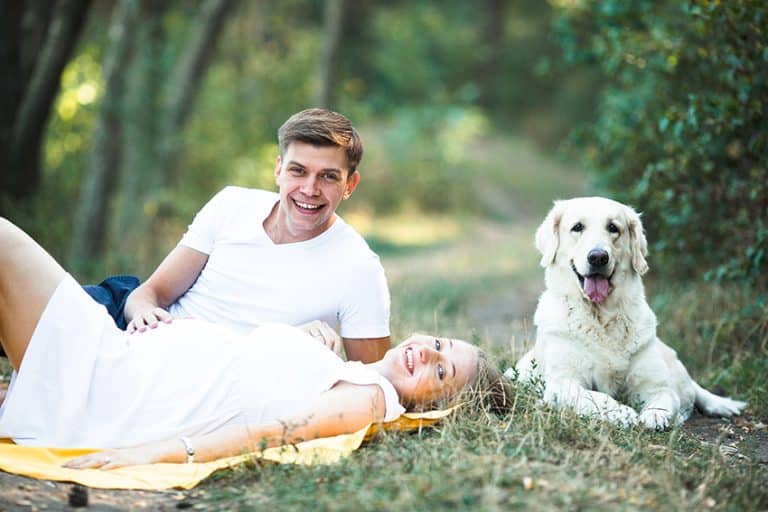
It’s an amazing thought, and the answer is probably yes. Dr. Ann Hohenhaus, DVM says, “I suspect that dogs can smell something we cannot in a pregnant woman.” That’s because the canine sense of smell is much stronger than ours. It’s possible that your furry friend can sense hormonal changes from pregnancy by the way your skin smells.
So, if you know that you have a baby on the way, you could have as much as 9 months to prepare. Check out our tips to discover some approaches that you can take to help your pal get ready for an infant.
Ways to Help Prepare Your Dog for a New Baby
For starters, there are some things you can do to prepare your pup in advance for the new arrival.
Visit the Vet
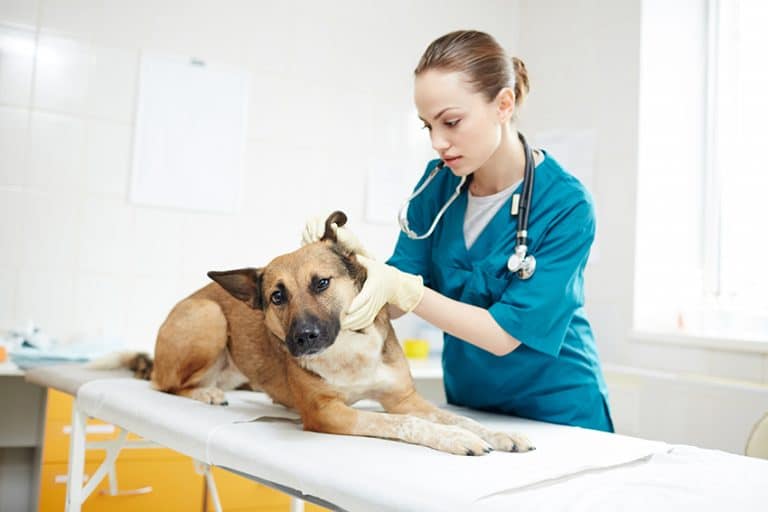
Before you bring your bundle of joy home, make sure you take your furbaby to the vet for a check-up. That way you’ll be sure Fido is up-to-date on his vaccinations and is free of parasites. And while you’re making plans to ensure your pup is healthy, remember to arrange for a caregiver when you’re in the hospital.
Get Started With Training
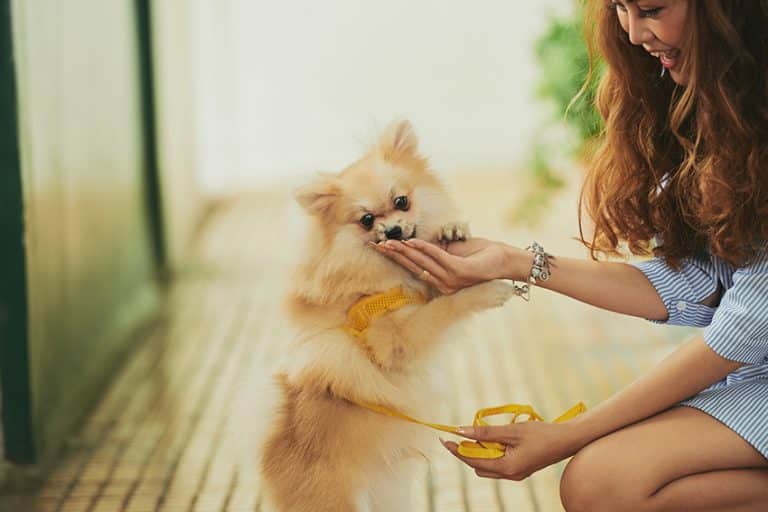
If your pooch hasn’t already been to obedience classes, get started as soon as you know you’re expecting. You want your pup to be well-behaved and responsive to voice commands. For dogs that have obedience training, keep reviewing the commands.
Start With the Basics
It’s important that your pooch masters basic skills like:
- Sit, down, and stay commands will help you keep your pup under control.
- Settle and wait quietly at the door or by your chair are useful skills for impulse control. These commands come in handy to keep your pal in order when you’re nursing your newborn.
- Leave it/Drop it are essential commands if you have a pup that loves plushies or other baby toys. Your pal needs to know he must leave the baby’s things alone.
- Greet people politely when they come for a visit. The last thing you need is a dog that jumps up on your visitors. It can be annoying for them and could be dangerous if you have your baby in your arms.
- Crate training helps prepare your special pal by teaching him to rest quietly in his crate. If things get hectic or you’re not able to supervise your pooch interacting with your baby, the kennel should be a safe, cozy spot for your furbaby.
- Recall or the ability to come when called is key. It only takes a moment in the confusion of welcoming excited visitors for your pup to slip out the door. If he knows to come on command, you can prevent your pal from running off and getting lost.
Add Special Skills
In addition to basic training, you may want to teach your pup some special skills to cope with the changes.
- Hand targeting gives your pup something to do when he’s near the baby. Teach your pooch to target or gently touch your hand with his nose. This behavior can help your furbaby focus and feel more comfortable around the infant. If Fido masters this skill, you may be able to teach him how to gently touch your baby with his nose.
- “Not Now” can give your four-footed friend a safe way out when he gets nervous around the baby. Some dogs don’t realize they can walk away from a crawling infant. By teaching your dog to go away, you’re helping them learn that they can move away from the baby if they’re feeling anxious or uncertain. That may help avoid your pooch snarling or snapping at your child.
To teach your pooch “not now”:
- Step 1: Show your dog a treat and say “not now” as you toss it about 4 feet away. Repeat several times.
- Step 2: Show the treat and say “not now”, but don’t toss the tidbit until your pal starts moving away from you. You can use an arm gesture to direct his movement. When you see him going the direction you indicate, say “yes” and toss the treat ahead of him. Repeat several times
- Step 3: Repeat step 2, but let your dog take several steps away before you toss the treat.
- Fetch is a helpful command with new children. Teach your pooch to play fetch with a toy. As your baby grows up, it can be a safe, fun way for your human and canine kids to interact.
Evaluate Your Dog’s Diet

Just like us, a dog’s diet can affect its health and attitude. You don’t feed children lots of sugar, and some are sensitive to certain food dyes. When it comes to your furbaby, you’re better off avoiding grains like corn, wheat, and soy as well as eggs, food dyes, and sugar. Added sugars aren’t any more healthy for canines than they are for us, and the other ingredients can be allergens.
On the plus side, a food ingredient to consider in your pal’s kibble is banana. It contains serotonin, which can help reduce aggression. If the dog food doesn’t have this fruit as an ingredient, you can always feed Fido a little banana every day.
Establish a Feeding Schedule
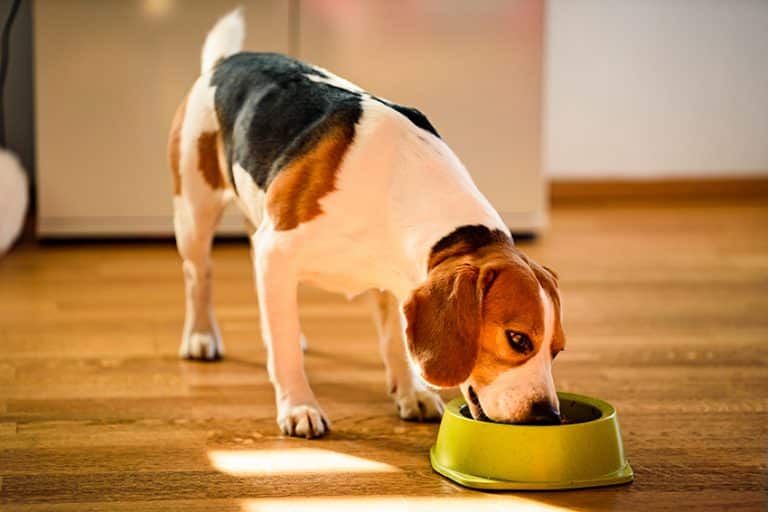
Don’t leave your pup’s food out free choice all day especially once your baby hits the crawling stage. It can encourage your pooch to guard his dish as a resource. Instead, put Fido on a daily feeding schedule. You furbaby should receive his meal after you and the kids eat to set up a pack order. Once he stops eating and leaves the bowl, pick it up. It won’t take him long to learn the new routine.
Set Up Boundaries
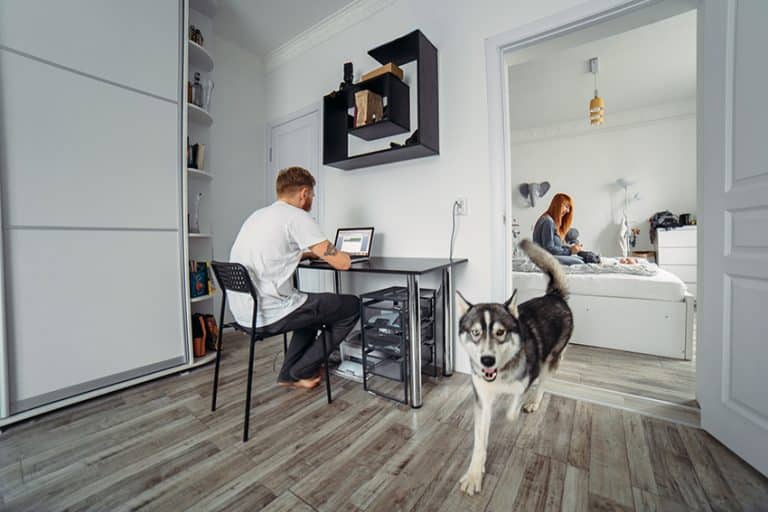
When you start baby-proofing the house, start setting up baby gates before the due date. You may also want to get some extra barriers. The point is, use the time before your baby arrives to teach your furbaby so that he knows which areas will be off-limits. You may also want to create a safe space for your pooch where he can go for some peace and quiet.
Take it from the pros: get a diaper pail with a secure cover. Dirty diapers are a real temptation for some dogs.
Train Your Pup to Walk on a Loose Lead
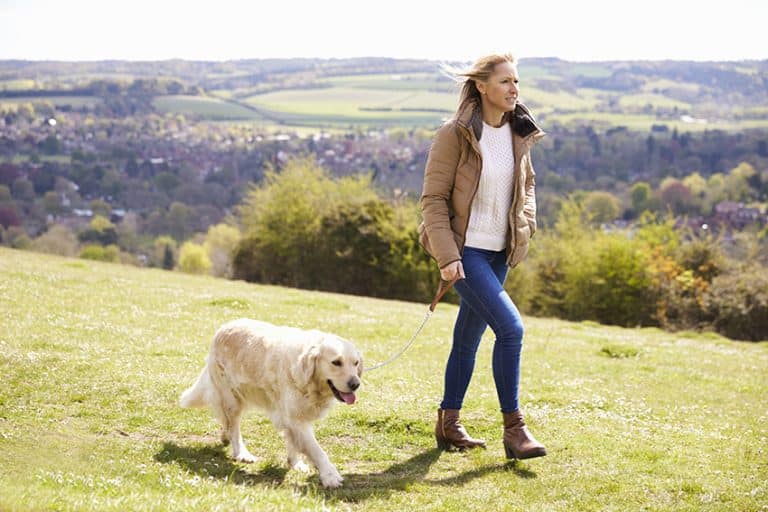
If you’re hoping to share quiet walks through the neighborhood with your dog and the new baby, start to teach your pooch how to walk on a loose leash ASAP. You may want to get a quality no-pull training harness. Take your pup for walks in the new gear and bring the stroller along to let him get used to it before your baby arrives.
While you’re walking praise and treat your pooch for walking quietly by your side. If Fido starts moving ahead and pulling, turn around and start walking in the opposite direction. Offer a treat when he catches up. It’s also helpful at this time to drill your pooch on the “leave it” command. You can use this order to prevent your pal from becoming distracted by his surroundings. The sooner you use the cue, the easier it will be to keep your pooch by your side.
Wean Your Pup From Constant Attention

You may be thinking you should lavish extra attention on your special pal before the new baby comes, but that can be counterproductive. They’ll be expecting to be the center of your affections when you bring home your bundle of joy. Instead, set up a schedule that includes random, short sessions where you cuddle and play together. At the same time, gradually decrease the amount you focus on your furbaby during the rest of the day. That way it will be easier for your pooch to share your attention and wait patiently for his turn.
Put New Rules in Place ASAP
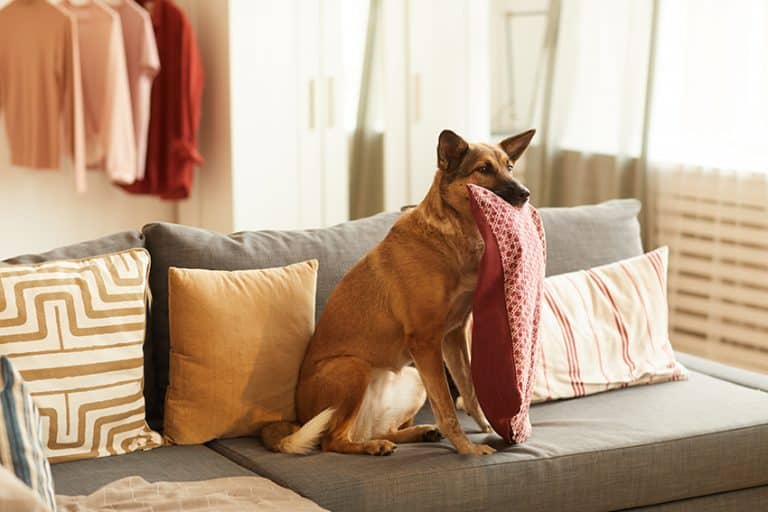
You’ll probably have different restrictions and expectations for Fido when you bring your baby home. Don’t wait until that day to institute new rules.
For example, if you want your pooch to stay off the furniture, start training him now. This is particularly important if your pal is used to snuggling in bed with you. Get a dog bet that’s comfortable and set it up where you expect your pup to sleep at night. You may need to use a crate or exercise pen to establish new sleeping habits.
Another thing to consider is how you want to manage time in the car. An infant’s skin is very delicate, and your pup could accidentally scratch the baby. Look into installing a pet barrier, getting a dog harness and seatbelt, or teaching your furbaby to ride in a crate. Again, whatever you choose, establish the routine now so that your pooch is used to it before you add a baby into the mix.
If you have one or more constant barkers, you may need to work with them. While sounding the alarm is a great deterrent for intruders, it can be disruptive for a napping baby. You don’t need your pooch barking at every skittering leaf or squirrel. That’s not to say that you need to train Fido to be absolutely silent. One of the better pieces of advice I got from a friend when my daughter was a newborn was to have let her fall asleep with background noise. That way, I could entertain guests without worrying about waking the baby.
Set Expectations for the Baby’s Room
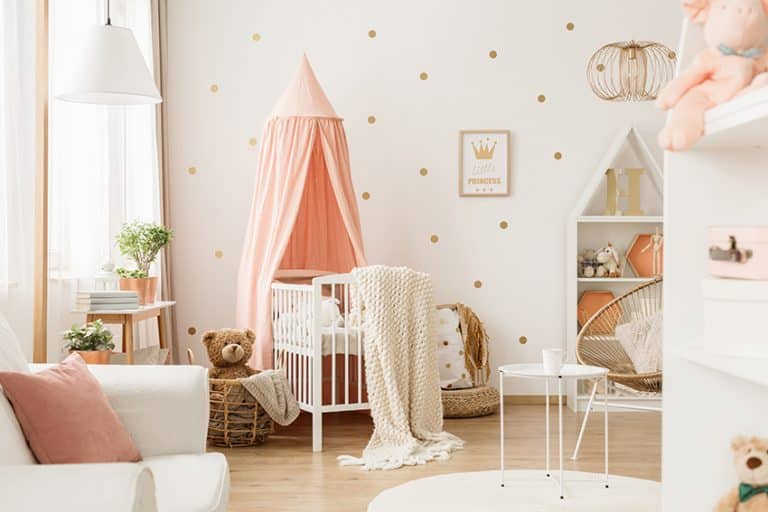
There’s no need to ban your pooch from the baby’s room, but he’ll need to know basic rules of behavior. Pick a quiet corner of the room to place a dog bed. Keep a treat jar handy, and place a few tidbits on the pillow when your pup isn’t watching. That will teach Fido to love the new spot and make it easier for the next phase.
Once your furry friend learns that the bed is a good place, teach him to settle when you need him out from under-foot. Then, when you’re nursing or rocking your baby to sleep in the nursery, your pup can curl up on his bed. Remember to reward him with an occasional treat. You could also invest in a chew toy or puzzle toy to keep your special pal occupied. If Fido has a hard time staying in place, you can set up a tether by attaching it to heavy furniture or screwing a hook into the baseboard.
If your canine companion likes a cozy mattress, you may have to teach him to stay out of the crib. Dogs that are able to jump or climb into the bassinet might try to do so. But it’s not safe to let your pooch sleep with a newborn. So, if your pup seems overly interested in the crib, call him away from the furniture and offer enthusiastic praise if he complies. Any time your pooch jumps up and places his paws on the side of the crib, immediately say, “Off” in a stern tone, grab his collar, and pull him away. For persistent pups, you may need to close the door or put up a safety gate when you’re not around.
Play House With a Baby Doll
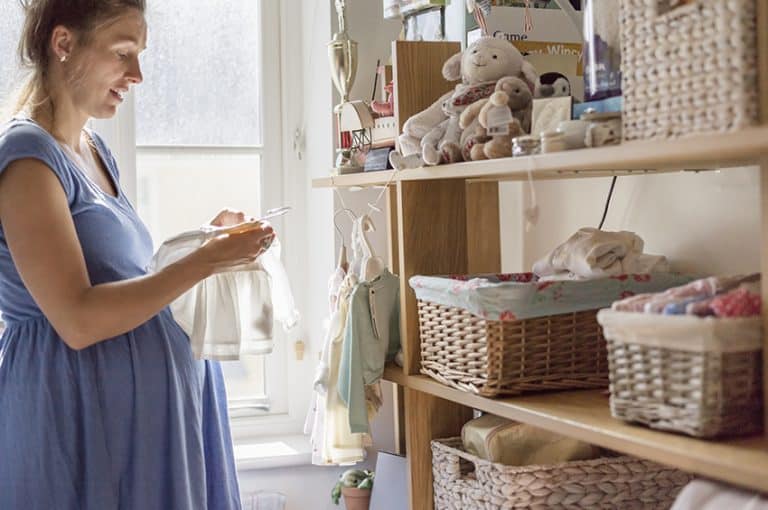
You can prepare your pooch by purchasing a baby doll with the same skin tone as your baby will have. Collect the gear you’ll be using with your newborn like swaddling blankets and diapers.
A few months before the baby’s due, spend about 20-30 minutes each night going through a routine similar to what you’ll do with your little one. Pretend to nurse and burp the baby, play with it, change diapers, practice putting it in a baby carrier and anything else you can think of. While you’re engaging in these activities, play the bumping game with your pup. It will be much easier to establish rules of etiquette now than when you’re busy with the baby.
Prepare Your Pooch for Handling
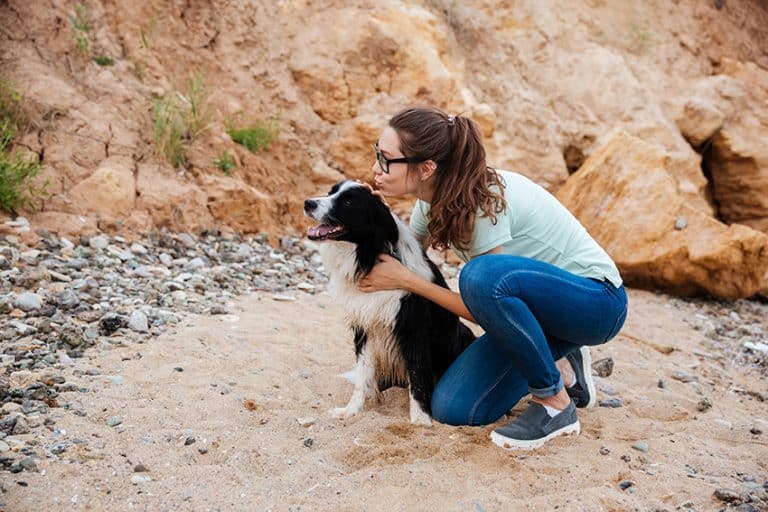
If your dog is nervous about being touched, you’ll want to work with him to get him used to being handled. For one, you’ll want to keep his nails trimmed, and that involves touching his feet and toes. But as the baby starts crawling, it will help if your pooch doesn’t freak when someone touches him. Spend lots of time now gently pulling his tail, feet, and ears. Give liberal treats and praise for calmly tolerating these actions.
Teach Toy and Floor Boundaries
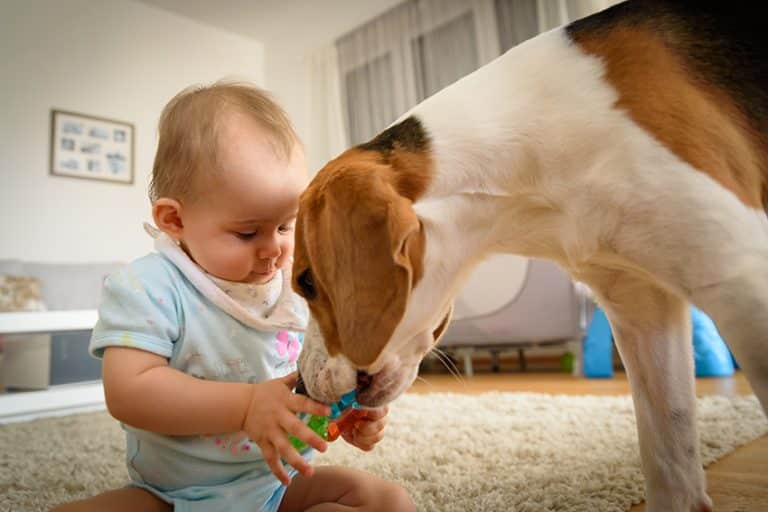
Dogs and babies both have fun toys. Your pal needs to know how to tell which ones are his and which ones belong to the baby. Practice drop or give cues with a variety of objects. That will help you when Fido thinks a dirty diaper is more interesting than his chew bone.
The other thing you want to teach your pup is to respond to your commands when you’re in unfamiliar positions. To do this, prepare a spot on the floor with a baby blanket. Put Fido in a down stay. Then pretend to change a diaper on a baby doll. Pretend to interact with the doll by nuzzling it and acting playful. If your pooch tries to get up, repeat the down command to keep him in position until you give a release order. Make sure you lavish your furbaby with treats and praise for his compliance.
Prepare for New Sounds, Smells, and Sights
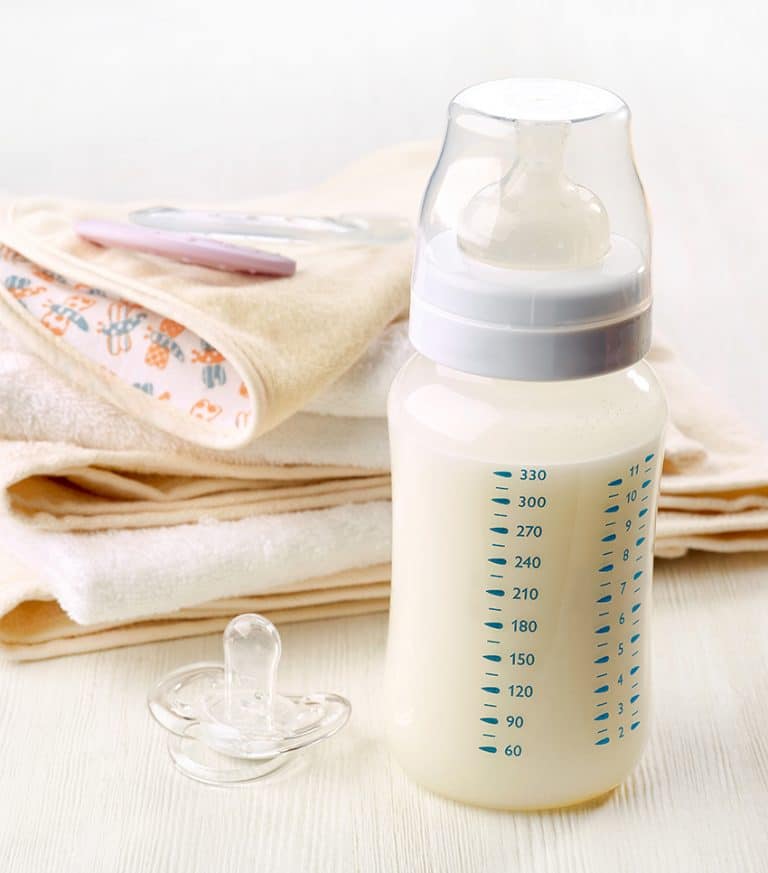
A new baby can turn the household upside down for a dog. So much is different about the way these miniature humans smell, the sounds they make, and how the move. Rather than shocking your pup’s system with everything at once, you can slowly introduce things to him before the big day. That way your special pal will feel a sense of familiarity.
Start with the baby supplies. Unwrap them a few items at a time and let your furbaby investigate them while you supervise. You can place things like baby toys, bouncy seats, swings, car seats, high chairs, and more in areas where Fido may normally find them. If your pooch tries to pick up a toy, gently redirect him to his playthings and teach him to leave the baby’s stuff alone.
To introduce your pal to new scents, use small quantities of the baby shampoo, lotion, powder, and creams that you purchase for the baby. When Fido smells the products on you, he’ll become familiar with them. You can also borrow a used baby blanket or clothing from one of your friends to let your pooch get used to the scent of an infant.
When it comes to noises, a baby’s cry can make some pups anxious. You can purchase a recording of baby sounds to play around your pooch. Use it frequently at times when you can give your special pal focused attention. Play the recording for about 5 or 10 minutes and offer lots of treats and affection. Then stop it and ignore Fido for a while, maybe ½ an hour. Repeat this process several times a day. Eventually, your pup will associate the baby sounds with positive experiences. Now, if your pooch is extra-sensitive about the noises, you may need to start by playing the recording quietly and increase the volume over time.
Socialize With Babies
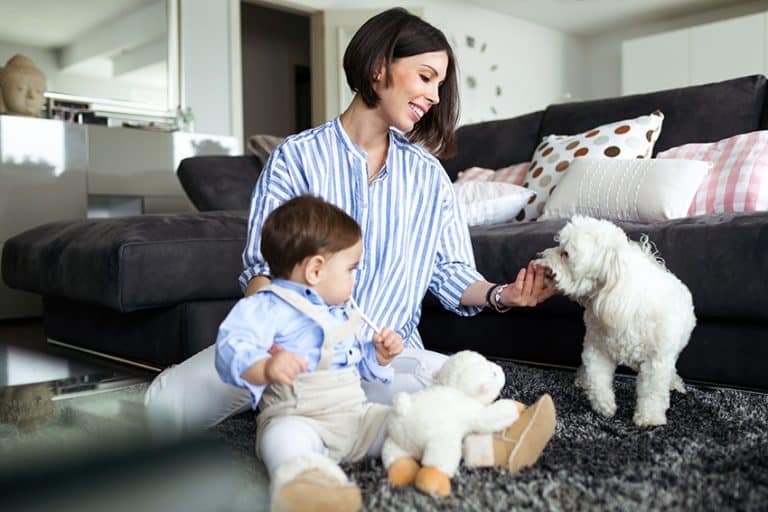
As soon as you know a little one will be joining your family, start exposing your pup to babies and young children. You can set up visits with friends that have children or take your furbaby to a pet-friendly park to meet little people. If it’s a new experience for your furry friend, be cautious and start slow. Keep Fido on a short lead, and use a muzzle if you have any concerns. Reward your pooch for positive interactions. You can use a clicker when you treat to condition your pal’s behavior.
Steps for Introducing Your Dog to a New Baby
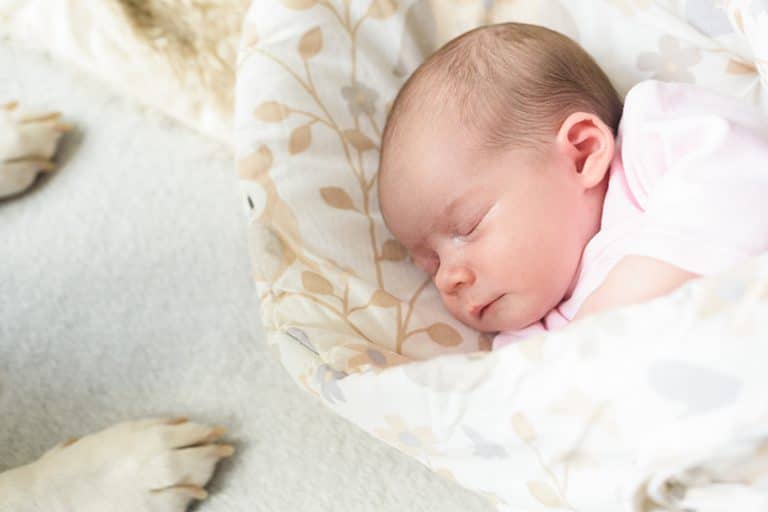
The key when you bring your new baby home is to have positive experiences from the beginning. Your pup’s first impression of the newest family addition is important.
Set Up Doggie Day Care
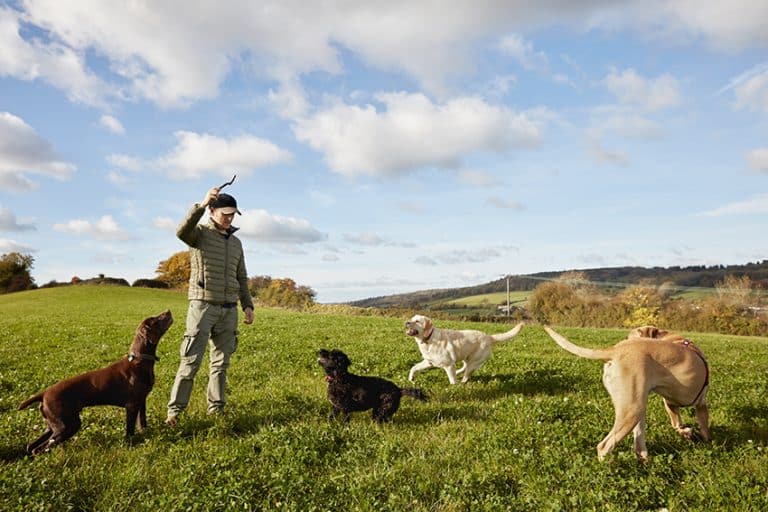
Face it. When you go into labor the last thing on your mind will be, “who’s going to watch the dog?” Make plans for a pet sitter in advance. While you’re at it, see if they can extend their services during those first few days of transition. You can set up arrangements with a professional service or talk to a willing neighbor or friend.
Bring Home Baby Smells
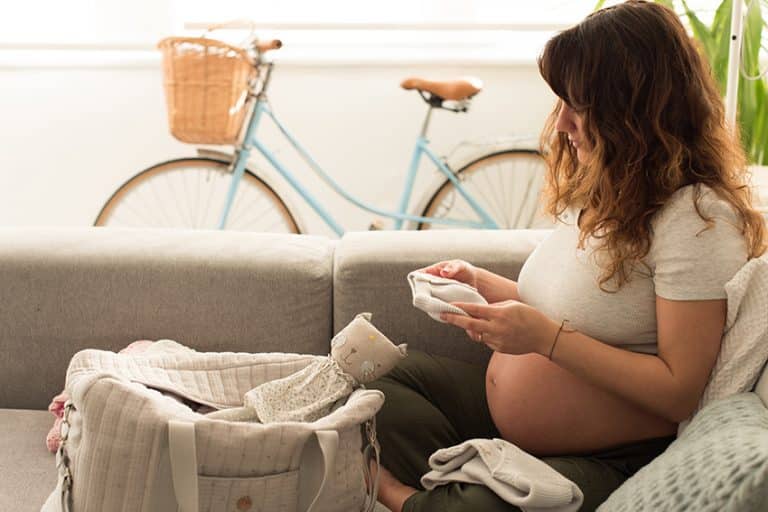
When you pack your hospital bag, include a few gallon-size ziplock bags. Collect items like infant booties, onesies, and hats when you change the baby’s clothes. Seal one piece in each bag. When your partner goes home to check on things and your pup, have him take an item out of one of the bags and attach it to himself before entering the house. Put a second piece underneath the dinner bowl, and rub another one on Fido’s favorite toy. Your furbaby will associate the baby’s scent with positive experiences and happy emotions.
Maintain a Positive Environment
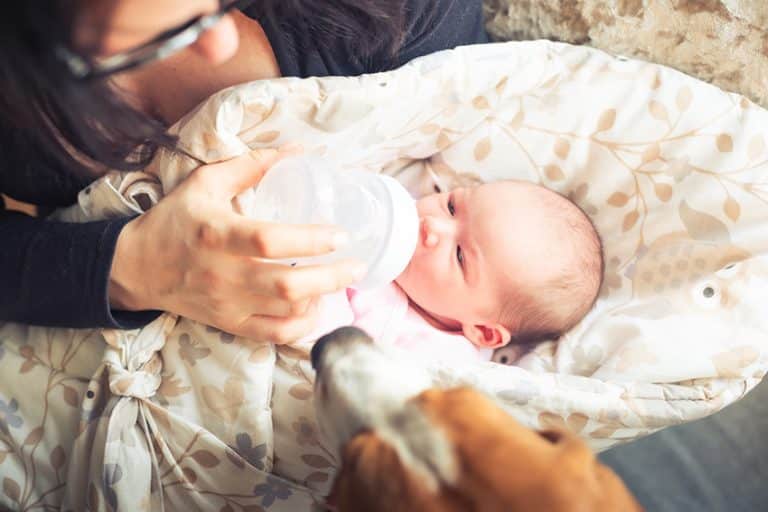
By bringing baby items home ahead of your child’s arrival, you can build positive emotions around the scent. You’ll want to keep that up when bringing your little one home. Avoid sharp tones and “no” with your pooch but rather use positive reinforcement to direct his behavior.
During the early days home, work to associate good experiences around the baby for your pooch. Rather than paying attention to your furbaby when the little one is sleeping and expecting Fido to be unseen and unheard while the baby is awake, try to do the opposite. As much as possible give your pooch pets, treats, and praise while you’re holding or interacting with your infant. Try to bring the baby with you in a stroller or carrier when you walk your pup. You can also schedule some of your child’s feedings to coincide with Fifi’s mealtimes. The more that your special pal associates happy experiences with an awake and active baby, the better.
On the flip side, keep the baby’s nap times low key with your pooch. Ignore him and get other things done. That way, he’ll start to anticipate when the baby will be awake again.
Feed Your Pup Frequently
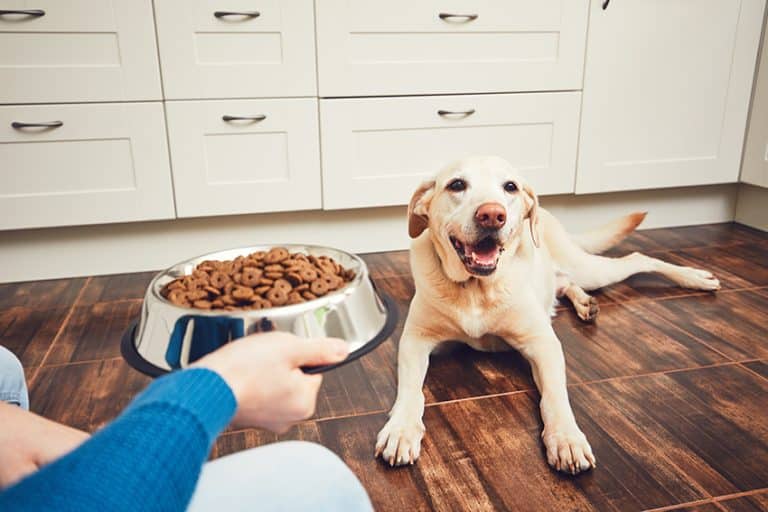
For the first few weeks after the baby comes home, try increasing the number of times you feed your pooch. Rather than giving him his allotted food in two meals, split it into 10 servings. Then feed every few hours, around nursing times. Chances are that your dog won’t know he’s not getting any extra food. He’ll just think he’s in doggie heaven! After a few weeks, you can slowly transition back. Go to 8 meals a day for half a week, then 6, then 4…
Associate Baby Sounds With Fun
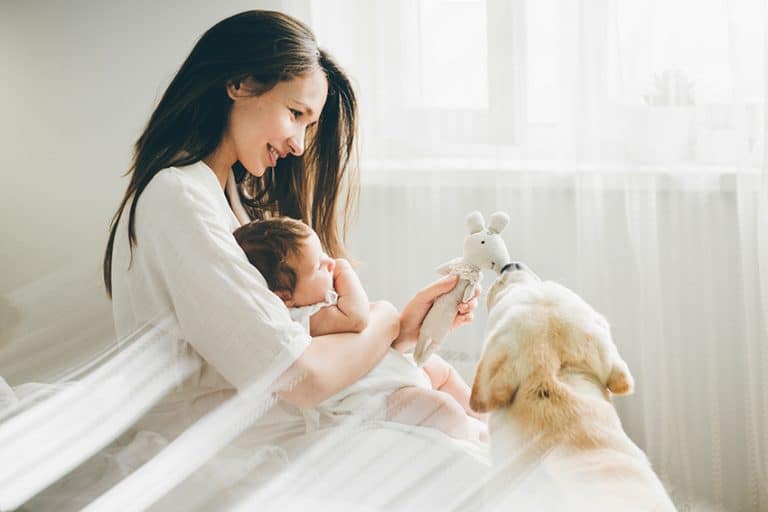
Some dogs tend to get nervous around a wailing baby. If your pup seems confused or upset and unable to ignore the cries, give him a little helping paw. Associate the sounds with things like special treats. Toss a tasty tidbit to your furbaby when the little one starts squealing. It won’t take long for your pal to associate the noises with yummy snacks.
Make “Not Now” Cue Enjoyable for Your Dog

While you want your pooch to feel comfortable around the baby, there are times his presence can be a nuisance. It’s helpful and safer for all of you if your pup knows how to move away on cue. To teach your pup to go away:
- Say the cue you’ll use, like “not now” or “go away”
- Show your furbaby a treat
- Toss the goodie a few feet away
- Repeat several times
- Once your pup masters this, wait until he starts to move away before you toss the tidbit
- Speak your cue
- Motion in the direction you want your pooch to move
- Once Fido starts going that direction, toss the treat past him and say “yes” in an affirming tone
As you continue the training, let your dog move further and further away before throwing the treat. Before you know it, your special pal will go several steps away from you. When he masters the skill, you can use it to get some space for yourself. It will also come in handy when the little one starts crawling. If your pup acts uncomfortable, say the cue to let them know it’s okay to move away from the baby.
Don’t Ignore Your Dog
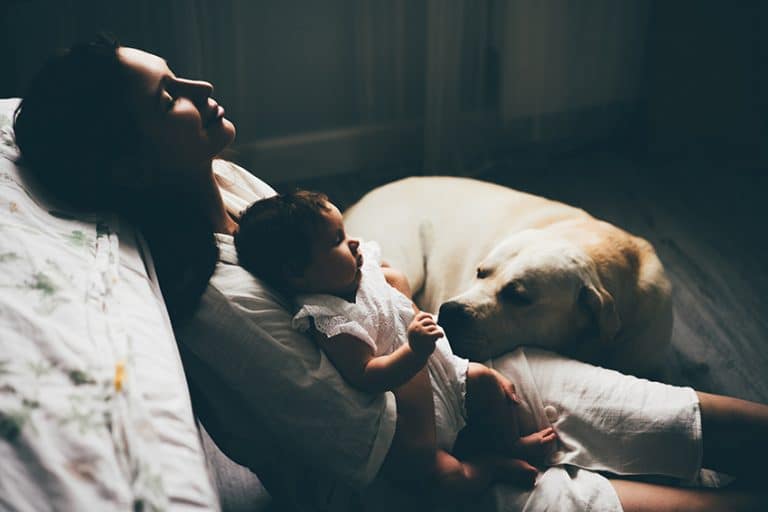
With a new baby, you’ll be very busy for a while. Be mindful amid all the excitement and activity that you don’t give Fido the cold shoulder. As pack animals, dogs are social. Your furbaby will want to be included, and he’s likely to be curious about the new human. Respond positively to your dog’s interest while maintaining safe boundaries. Show enthusiasm when Fido wants to check the child out, but maintain a reasonable distance for now.
Establish Quiet Times With the Baby
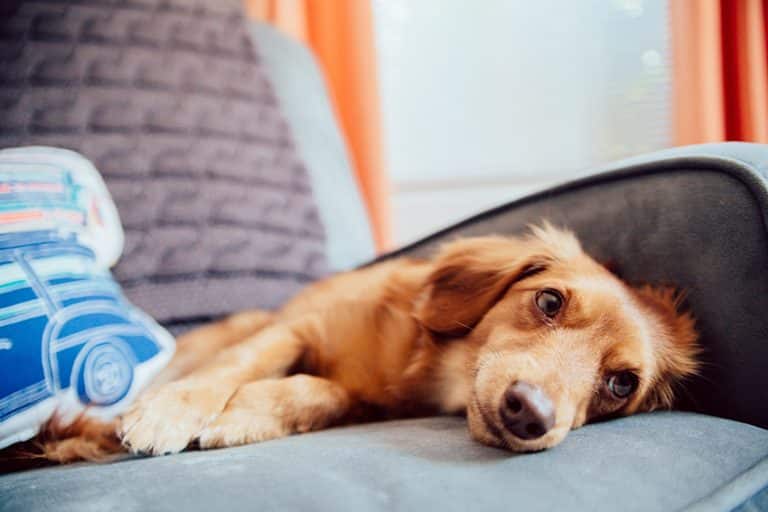
For those times that you don’t want your canine companion underfoot, you can teach her to settle in a down stay. Remember that dog bed in the baby’s room? You can have your pup settle on the bed for times when you’re nursing or rocking your little one. Offer your furbaby a tasty treat, a fun puzzle toy, or a chew bone to keep him occupied.
Teach Your Dog to Sniff the Baby on Cue
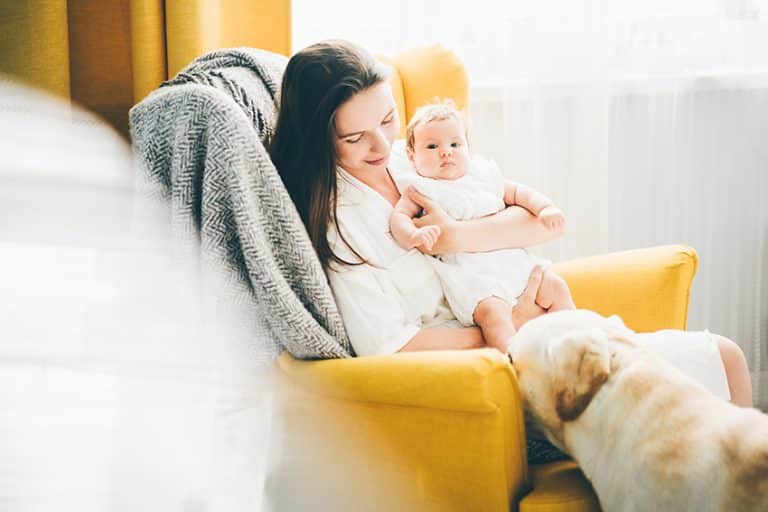
You may have a pooch that’s nervous around a new baby. If your pup goes to extreme measures to avoid your little one, you can teach him to gently touch the infant with his nose on cue. That way, your pooch will have a brief, safe interaction with your child that gives him a chance to acclimate to the baby’s scent, sounds, and appearance.
The training starts by teaching your special pal to nose bump your hand with a cue like “touch”. Once Fido masters this behavior, you can work with him to transfer the action to the baby. To do this, bring your hand against your infant’s head with your palm facing out. Issue the “touch” cue to your furbaby. Praise and reward him for obeying your command. Repeat several times for positive reinforcement.
For phase 2, you’ll be making a slight change. Start as before with your hand against your baby and tell your pup, “touch”. Just before Fido reaches your palm, quickly move your hand out of the contact zone so that your pooch accidentally touches the baby. Immediately give positive praise like “Yes” or “good” and treat your dog. Keep repeating until your furbaby naturally touches the baby’s head. Once that happens, you can practice by pointing to the baby when you cue your dog.
Once your pooch learns it’s safe and rewarding to touch the baby, he may show more initiative to sniff the baby without prompting. Praise and reward friendly behavior so that your four-footed friend learns it’s not that scary to be around an infant.
Give Your Pup a Safe Zone
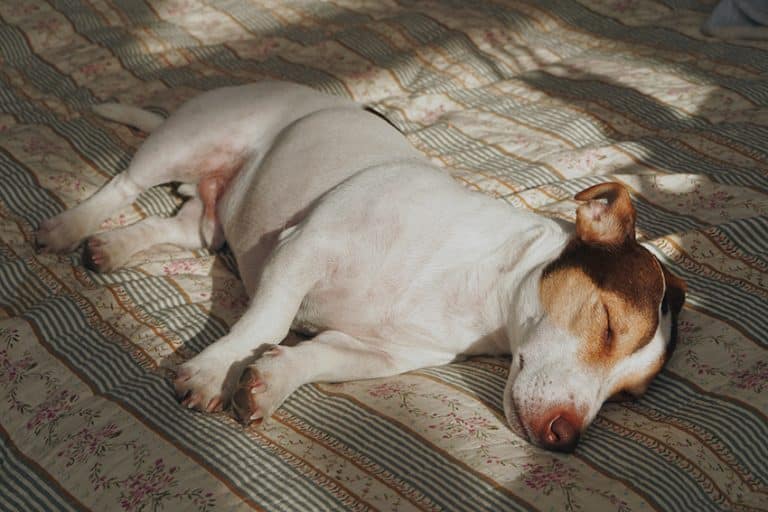
Believe me, it won’t be long before your little one starts crawling all over the place. Whether you pooch loves to be around the baby or is cautiously tolerant, he’ll need a safe retreat when he needs a break. Set up a low barrier or an elevated platform for your special pal that the child can’t reach. Teach your canine companion how to jump over the gate or climb up on the raised surface. Dogs that have an escape route are less likely to bite for self-protection than pups that feel cornered.
Watch Your Dog’s Body Language
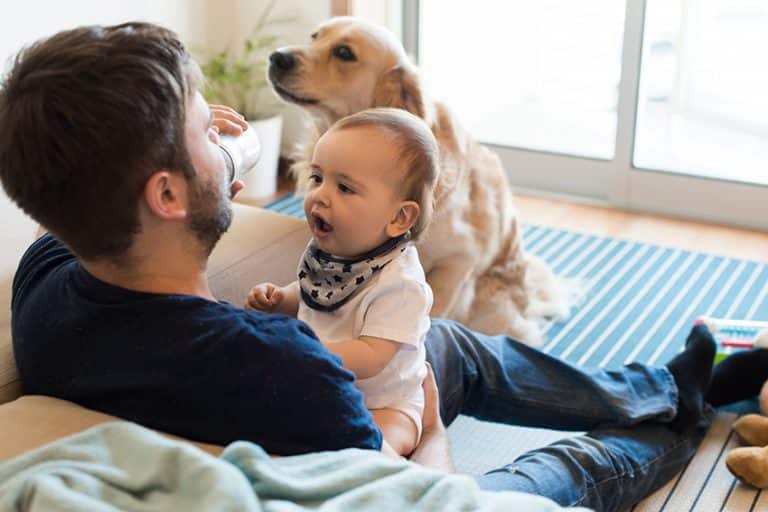
Like us, our dogs communicate their emotions through body language. Learn to read your pup’s cues, especially the ones that indicate he’s not happy or feels uncomfortable. If you hear growling or see barred teeth or raised hair, remove your baby from the area. Watch for signs that your pooch is fearful or stressed. Signs include:
- Panting
- Pinning his tail between his legs
- Tense body movements
- Trembling
- Trying to hide or move away from the situation
When you notice your furbaby exhibiting these behaviors around your child, diffuse the situation by separating them.
Supervise Interactions

When you have a baby, toddler, or young child, it’s important for you to supervise their interactions with your dog. Even when you have a calm pup that loves to be around children, things can happen. Kids and dogs have an unpredictable side. If your little one does something that causes your pooch to feel scared or threatened, Fido’s first reaction might be to protect himself. Any time that your furbaby shows signs of aggression or fear toward your child, separate them. If you have any ongoing concerns, speak to your veterinarian or a specialist in animal behavior.
Use Safety Gates
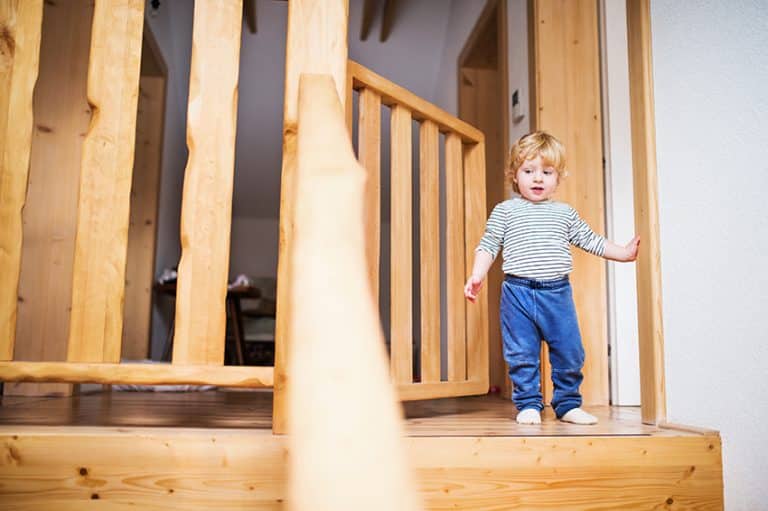
Safety gates aren’t just for stairs. They provide a helpful barrier to keep your pooch in a restricted area while the baby has floor time. Gates can also provide your pup with a safe zone away from a crawling child. For the best results, install them before the baby comes. That way you’ll have time to help your furbaby become accustomed to the restrictions.
Teach Your Child How to Interact Properly With Your Dog
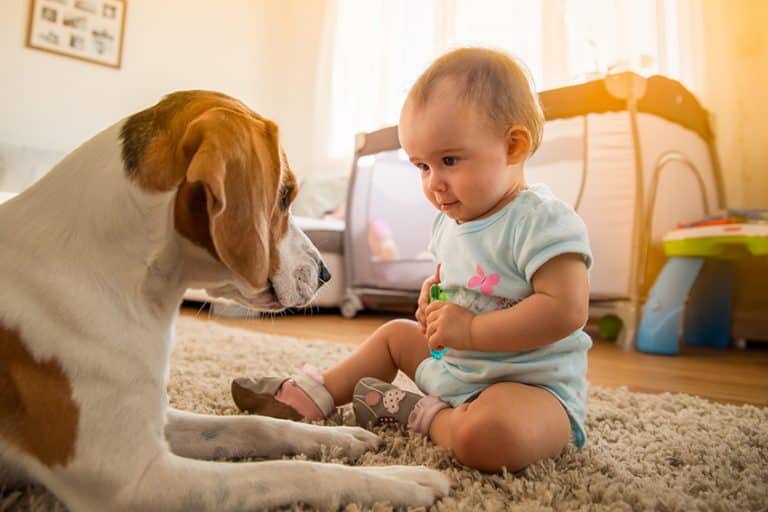
Kids need to learn how to be gentle with their pups. Teach your youngster how to scratch and stroke your pooch kindly. Stress with your child that it’s NEVER okay to pinch, hit, kick, poke, ride, tease, or purposefully scare your dog.
In addition to teaching quiet interactions, you can show your little one how to play games like fetch, hide-and-seek, or tug-of-war with the dog. If your youngster is old enough, encourage them to use clicker training to teach fun tricks like shake, roll over, or speak.
If your obedience school allows youngsters, get your child involved in Fido’s basic training. Your kid will learn how to interact properly with your pooch, and with your encouragement, your furbaby will learn to obey your child. At first, you may need to support your youngster. When your dog immediately complies with commands, let your kid treat Fido but join in enthusiastic praise. If your pup is slow to obey, repeat the command right after your child. It won’t take your special pal long to figure out that he might as well comply with the first cue to get the treat faster.
Avoid Checking Your Dog’s Ears Around Your Young Children
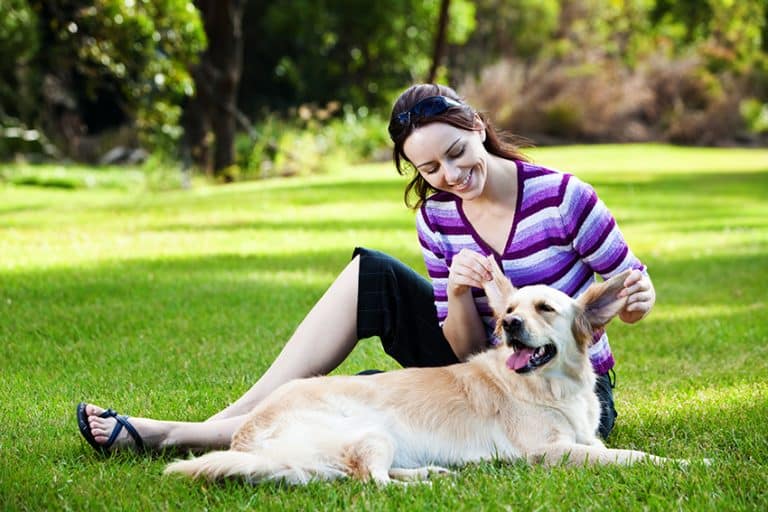
When you need to turn your dog’s ears over to check them, do it when your toddler or baby isn’t around to watch. You don’t want your little ones to think they can do it. Face it, tugging ears is already a big temptation for youngsters.
Preparing for the Next Baby
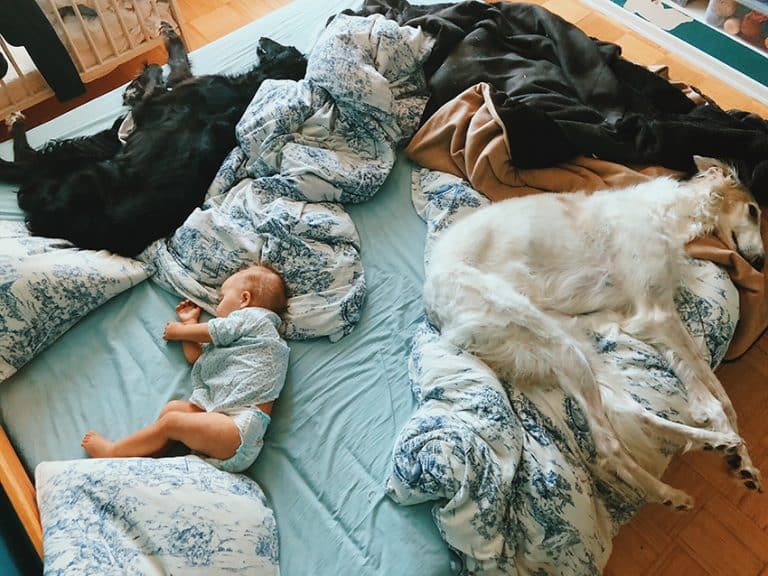
If you’re planning to have another child or children, remember to use these tips and steps to get prepared every time. Yes, your pup should be more adjusted to babies, but each new family member will mean changes to the routine. And, just like no two dogs are alike, neither are infants. Each little one will have its unique scent and nuances in sounds.
An Ounce of Preparation Is Worth the Effort
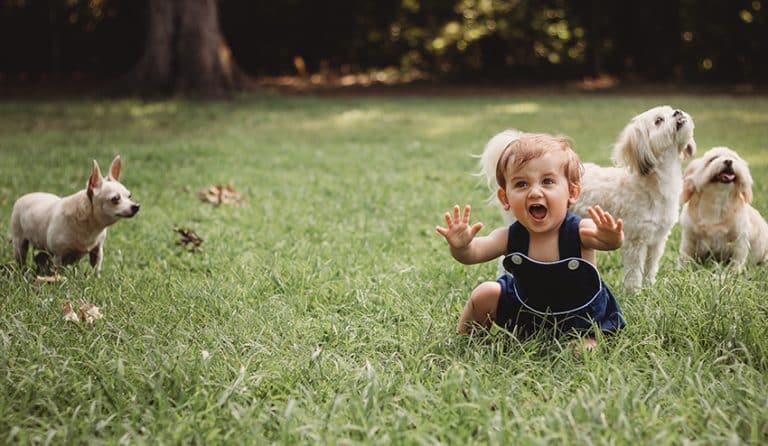
I know…it can be hard enough getting things ready for a new baby. On top of all that, the last thing you need is to add worry about how your dog will respond to another family member. The good news is that with some effort, you can prepare Fido to welcome your little one. If you’re willing to invest the time to train your pooch, he can grow into a loving pal for your child.

